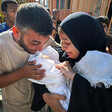Rights and Accountability 26 June 2018

The decline in infant mortality in Gaza has stagnated since 2006, according to a new study.
APA imagesInfant mortality in Gaza, in sharp decline since the 1960s, has stagnated over the past decade, according to a new study.
The estimated infant mortality rate amongst Palestinian refugees in the territory has not declined since 2006. Refugees make up about 70 percent of Gaza’s population of two million.
This is an alarm bell about the health of Gaza’s whole population, experts say.
The period of stagnation coincides with Israel’s ongoing siege on the territory that has hit nearly all aspects of life hard.
Infant mortality – the death of a child within the first year of life – is decreasing in most of the world.
UNRWA, the United Nations agency for Palestine refugees, called the stalled decline in Gaza an “alarming trend.”
“Infant mortality is a barometer of the health of an entire population,” Dr. Akihiro Seita, director of UNRWA’s health department and a co-author of the study, stated.
Stagnated decline in infant mortality
There had been huge improvements in the chances of survival for babies in Gaza. Estimated infant mortality fell from 127 per 1,000 live births in 1960 to 20.2 in 2006, previous UNRWA studies found.
In 2011 the rate was measured at 22.4.
A follow-up survey conducted in 2015 – the focus of the new report published by PLoS ONE journal – found an estimated infant mortality rate of 22.7 percent.
The authors of the study had previously found that the neonatal mortality rate – the number of babies dying during the first 28 days of life – had significantly risen since 2006.
That study, published in 2015, found that the neonatal mortality rate among babies born to Palestinian refugees in Gaza had risen from 12.1 per 1,000 live births in 2006 to 20.3 in 2011.
“There is no evidence from the current study that this rise has persisted,” the authors state, but add that work needs to be done to understand why the infant and newborn mortality rates have stopped going down.
For years Gaza’s health sector has been on the verge of collapse after successive Israeli assaults, chronic power shortages, drug shortages and deteriorating functionality of medical equipment due to Israel’s blockade.
The authors state that “it is reasonable to assume” that these factors “have had an impact on the quality of medical care with a consequent impact on infant mortality.”
“Although it is not possible with our data to attribute the stalled decline in infant mortality to the siege, it should be noted that the stalling began at the same time as the siege,” the authors add.
The study also points out the “widely divergent” infant mortality rates in Gaza versus those in Israel, which are far lower.
The study states that infant mortality in Israel fell below 20 per 1,000 live births in 1977, and fell to 3 per 1,000 in 2015.
However, different methodologies have been used to estimate infant mortality, complicating comparisons between different populations.
Crisis
There is no doubt that Gaza’s health sector crisis is largely of Israel’s making.
Israel’s use of live fire during Great March of Return protests along Gaza’s eastern boundary, killing more than 100 and wounding thousands more, have exacerbated the pressure on overstretched hospitals.
Government hospitals in Gaza suspended care to non-emergency patients due to the influx of injuries at the height of the protests.
The outlook for Gaza’s beleaguered healthcare system is grim.
Improving care for mothers and newborns is critical to reducing neonatal deaths and infant mortality, according to the study.
But it warns that without a “healthier political and socioeconomic situation,” and in the face of severe cuts to UNRWA’s funding, reducing infant mortality will “remain challenging.”
The United States was the largest single donor to UNRWA before the Trump administration announced cuts in contributions to the agency in January.
The US has since withheld $305 million, leaving the agency scrambling to raise $200 million in emergency funds to cover such basics as rice, flour, sugar and education.
Earlier this month, former UN Secretary-General Kofi Annan warned that if the shortfall is not met soon, UNRWA “may be unable to provide schooling for half a million children in the coming school year, and be obliged to reduce other key humanitarian services.”






Comments
This shocking news offers one
Permalink tom hall replied on
This shocking news offers one more insight as to why the Israeli blockade of Gaza must be lifted. Currently, a new flotilla has assembled in the Mediterranean for the purpose of sailing to the beleaguered population. Israel can be expected to react as in the past, with violent, lawless interdiction on the high seas. The Real News correspondent Dimitri Lascaris is aboard one of the vessels and is supplying video reports from the scene. Here's the latest:
https://therealnews.com/storie...